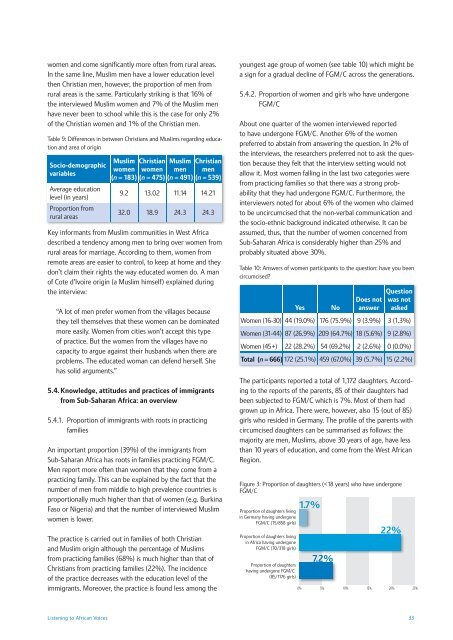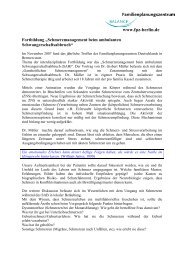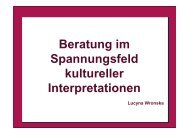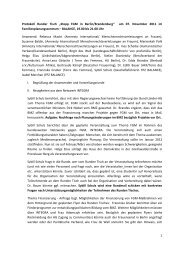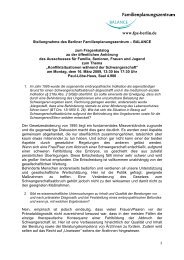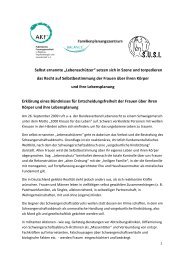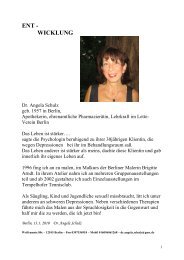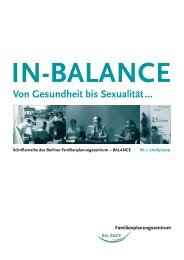Listening to African Voices - FPZ
Listening to African Voices - FPZ
Listening to African Voices - FPZ
Create successful ePaper yourself
Turn your PDF publications into a flip-book with our unique Google optimized e-Paper software.
women and come significantly more often from rural areas.In the same line, Muslim men have a lower education levelthen Christian men, however, the proportion of men fromrural areas is the same. Particularly striking is that 16% ofthe interviewed Muslim women and 7% of the Muslim menhave never been <strong>to</strong> school while this is the case for only 2%of the Christian women and 1% of the Christian men.Table 9: Differences in between Christians and Muslims regarding educationand area of originSocio-demographicvariablesAverage educationlevel (in years)Proportion fromrural areasMuslimwomen(n = 183)Christianwomen(n = 475)Muslimmen(n = 491)Key informants from Muslim communities in West Africadescribed a tendency among men <strong>to</strong> bring over women fromrural areas for marriage. According <strong>to</strong> them, women fromremote areas are easier <strong>to</strong> control, <strong>to</strong> keep at home and theydon’t claim their rights the way educated women do. A manof Cote d’Ivoire origin (a Muslim himself) explained duringthe interview:“A lot of men prefer women from the villages becausethey tell themselves that these women can be dominatedmore easily. Women from cities won’t accept this typeof practice. But the women from the villages have nocapacity <strong>to</strong> argue against their husbands when there areproblems. The educated woman can defend herself. Shehas solid arguments.”5.4. Knowledge, attitudes and practices of immigrantsfrom Sub-Saharan Africa: an overview5.4.1. Proportion of immigrants with roots in practicingfamiliesChristianmen(n = 539)9.2 13.02 11.14 14.2132.0 18.9 24.3 24.3An important proportion (39%) of the immigrants fromSub-Saharan Africa has roots in families practicing FGM/C.Men report more often than women that they come from apracticing family. This can be explained by the fact that thenumber of men from middle <strong>to</strong> high prevalence countries isproportionally much higher than that of women (e.g. BurkinaFaso or Nigeria) and that the number of interviewed Muslimwomen is lower.The practice is carried out in families of both Christianand Muslim origin although the percentage of Muslimsfrom practicing families (68%) is much higher than that ofChristians from practicing families (22%). The incidenceof the practice decreases with the education level of theimmigrants. Moreover, the practice is found less among theyoungest age group of women (see table 10) which might bea sign for a gradual decline of FGM/C across the generations.5.4.2. Proportion of women and girls who have undergoneFGM/CAbout one quarter of the women interviewed reported<strong>to</strong> have undergone FGM/C. Another 6% of the womenpreferred <strong>to</strong> abstain from answering the question. In 2% ofthe interviews, the researchers preferred not <strong>to</strong> ask the questionbecause they felt that the interview setting would notallow it. Most women falling in the last two categories werefrom practicing families so that there was a strong probabilitythat they had undergone FGM/C. Furthermore, theinterviewers noted for about 6% of the women who claimed<strong>to</strong> be uncircumcised that the non-verbal communication andthe socio-ethnic background indicated otherwise. It can beassumed, thus, that the number of women concerned fromSub-Saharan Africa is considerably higher than 25% andprobably situated above 30%.Table 10: Answers of women participants <strong>to</strong> the question: have you beencircumcised?YesNoDoes notanswerQuestionwas notaskedWomen (16-30) 44 (19.0%) 176 (75.9%) 9 (3.9%) 3 (1.3%)Women (31-44) 87 (26.9%) 209 (64.7%) 18 (5.6%) 9 (2.8%)Women (45+) 22 (28.2%) 54 (69.2%) 2 (2.6%) 0 (0.0%)Total (n = 666) 172 (25.1%) 459 (67.0%) 39 (5.7%) 15 (2.2%)The participants reported a <strong>to</strong>tal of 1,172 daughters. According<strong>to</strong> the reports of the parents, 85 of their daughters hadbeen subjected <strong>to</strong> FGM/C which is 7%. Most of them hadgrown up in Africa. There were, however, also 15 (out of 85)girls who resided in Germany. The profile of the parents withcircumcised daughters can be summarised as follows: themajority are men, Muslims, above 30 years of age, have lessthan 10 years of education, and come from the West <strong>African</strong>Region.Figure 3: Proportion of daughters (


